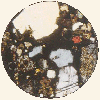In the late 1990s, petrologist Beth Miksa began collecting and analyzing more than 240 sand samples from areas along the entire San Pedro River Valley in Arizona and Mexico. Her innovative petrofacies research using this data has played an important part in the Archaeology Southwest’s investigations of the Late Classic Period (A.D. 1350–1450) in the region.
The composition of sands from washes running into the San Pedro River is highly variable. By applying petrofacies analysis techniques differences in texture, size, shape, and composition of grains in each sand sample were identified under a microscope. These differences combined to form a distinctive, recognizable “fingerprint” for sand originating in specific areas along the river valley.

The first step was to characterize modern sand samples. Then Dr. Miksa examined the sand tempers found in ancient pottery sherds from the valley. She studied the ceramics recovered during Archaeology Southwest’s recent test excavations, and she also reexamined pottery from past excavations. By matching the sand temper seen in these sherds with the “fingerprints” of Beth’s sand samples, the research team pinpointed specific areas of past ceramic production along the river. And, by comparing where a specific pot was made with where the pot was found by archaeologists, we were able to gain interesting insights into how people of the area were trading and interacting with each other.
To learn more about this research, visit the San Pedro Petrofacies Project at Desert Archaeology, Inc.
This petrofacies research was made possible by a grant from the National Science Foundation.